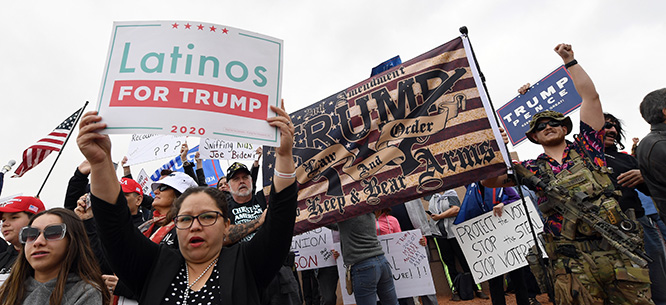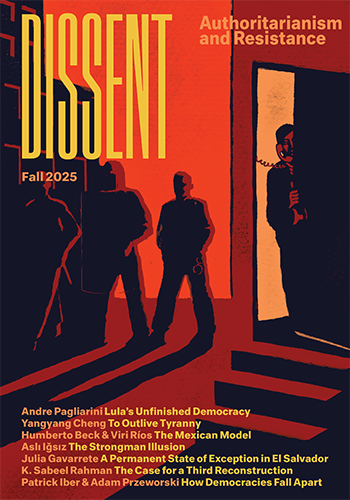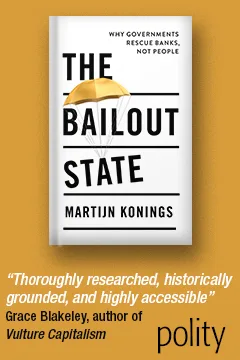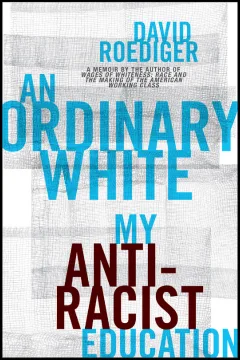¿Por Qué MAGA?
¿Por Qué MAGA?
Progressives will only make lasting progress with Latino voters if they examine not just why Trump was appealing, but also why the left was not.

The rightward drift of Latinos—especially Latino men—in the 2024 presidential election shocked the political establishment. According to NBC News exit polls, 54 percent of Latino men and 39 percent of Latina women voted for Donald Trump, enough to toss a bomb into the dreams of a come-from-behind Democratic victory. It was bewildering to many: wasn’t Trump a xenophobe who delighted in separating families, disparaging diversity, and cutting social spending? But it should not have been a surprise.
After all, there was already a slight conservative tilt in the Latino vote back in 2020, but it was dismissed by some political consultants. Meanwhile, anyone with an ear to the ground through the summer of 2024 was hearing grumbles from both U.S.-born and long-term-resident immigrant Latinos who wondered why the new wave of migrants in 2022 and 2023 was getting “special” support, including temporary housing assistance upon arrival and work permits for those applying for asylum.
This surprising (to some) anti-immigrant impulse emerged on top of the unease triggered by an economy that seemed both too anemic and too expensive. Latino voters are overwhelmingly working class, and thus especially sensitive to the ravages of inflation. Their class orientation is also complex, shaped less by resentment of the rich than by a sense that work should be rewarded. As such, Trump’s status as a successful businessman—or at least the fact that he played one on TV—is not necessarily a turn-off for Hispanic voters who dream of starting their own small businesses.
The Latino red tide was, of course, greeted with glee by MAGA forces: finally, a breakthrough to the country’s largest and still growing minority group, one that could drive a permanent realignment of an increasingly multicultural working class behind conservative or at least Trumpian principles. By contrast, the results brought chagrin to progressive forces who had long viewed (and misconstrued) the “Latinx” population through exactly the distant ideological prism that led them to adopt the word “Latinx,” a term that in 2023 was used by only 4 percent of the population in question (with 75 percent of those who had actually heard the term saying it should not be used).
Meanwhile, some Black analysts and political figures lamented the defeat of a Black woman at the hands and ballots of brown men. Steve Phillips’s optimistic analysis in Brown Is the New White had conceived of an emerging rainbow coalition of people of color joined with progressive whites for a new American majority. But apparently brown had instead drifted to the old white—and some Black Americans felt that Trump’s promised (and now ongoing) reign of terror against immigrants was just desserts for a group gone bad.
What Went Wrong?
To even ask what went wrong is to assume that a particular outcome was preordained because of Latinidad. It misses the fact that Latino identity has always been constructed, sometimes by media companies trying to make a unified market of consumers hailing from many different countries, but also by political entrepreneurs—both Latino and non-Latino—seeking to create and manipulate a sense of community to serve particular political projects.
Indeed, the popularization of the designation “Hispanic” occurred when Richard Nixon shredded the Republican Party’s relationship with Black voters through the adoption of the Southern strategy, aimed at capturing white Democrats disaffected by civil rights reform. As Republicans sought a new minority group to court—one that would allow them to collect new votes from resentful whites while denying charges of racism—“Hispanics” were given a new census category, small business support, and eventually a Ronald Reagan–supported amnesty in the mid-1980s, which provided a path to citizenship for an earlier generation of undocumented immigrants.
These efforts could have cemented a positive relationship—Reagan remains an icon for many older Mexican Americans—but the opportunity for political realignment was quickly squandered. By the time the bulk of the newly legalized population had satisfied the residency requirements to become citizens, California’s Republican governor Pete Wilson tarnished the party’s brand by linking his 1994 reelection campaign to Proposition 187, a statewide ballot measure that threatened to deny crucial services to those in the country without authorization.
The initiative passed overwhelmingly (though it was later ruled unconstitutional by a federal judge). In the 1970s and 1980s, nearly half of all new immigrants coming to the United States settled in the Golden State—the sort of “immigrant shock” that later fueled Trump’s reelection in 2024. But Prop 187’s victory also prompted a wave of Latino activism, which came just as California was becoming a majority-minority state. This demographic shift made the idea of a coalition of “people of color” seem not just viable but politically salient. Newly naturalized and newly engaged voters brought change: there was a sharp increase in Latino elected officials in the state, generally working in alliance with Black political leaders, and California began leading the nation on issues of immigrant inclusion.
The idea that Latinos normally lean left was reinforced in the 2010s, when Arizona’s attack on immigrants through SB 1070 (known as the “show me your papers” law, because it required local law enforcement to ask about immigration status in routine encounters) provoked another wave of Latino activism in that state. From 2008 until 2018, no Democratic candidate won a statewide election in Arizona; now the governor, both senators, the secretary of state, and the attorney general are all Democrats, even if the state legislature is solidly in Republican hands. Partly because of these experiences in the Southwest—along with the traditional solid blue hue of Puerto Rican voters—many assumed that Hispanics were progressive by default. (One exception is Cuban Americans, although even in that group Obama made big inroads and raised Democratic hopes of realignment.)
As such, few prognosticators had a Trump near-victory among Latino voters on their bingo cards. Surely, they thought, no self-respecting Latino would risk the deportation of a loved one, the pain of their family being torn apart, or the body blow of enforcement activities that would send migrants to countries (and prisons) from which they had not emigrated or even visited.
Some seem to believe that we need only wait for electoral buyer’s remorse to bring Latinos and others back to the progressive fold. After all, the Trump administration has given up on cheap eggs and supported expensive tariffs. It has violated due process, celebrated cruelty, and denied protected status for Venezuelans and others who had hoped that they would be spared and that their left-leaning home countries would be attacked. And it has proposed cuts to government spending that will limit opportunity for Latino youth, who now comprise 26 percent of all young people in the United States, double the share of Black youth.
Certainly, the current chaos on the streets of Los Angeles should be enough to trigger a rethinking of political allegiances. ICE has been unleashed, in cooperation with other federal agencies, to conduct raids that are more likely to pick up a car washer who has lived in the United States for thirty years than a gang member who recently arrived. Community members have engaged in mass protests and have also responded directly, recording arrests and shouting obscenities at masked ICE agents who refuse to identify themselves.
But relying on hot rage and bubbling resentment to cure the pro-Trump sentiment that infected Latino voters is, at best, reactive. Progressives will only make lasting progress with Latino voters if their strategy includes a deep examination not just of why Trump was appealing, but also of why the left was not. That in turn requires going beyond electioneering to the more grassroots tasks of community organizing, consciousness-building, and alliance formation—the terrain of movements, not ambitious political entrepreneurs.
Dissecting Identity
It is in movement, and its absence, that political mindsets are determined. Most electoral efforts assume that there is a group to be activated, if only we can reach them. This is the basis of the perennial view of the Latino community as a “sleeping giant” that can be stirred leftward with just the right nudge to awaken it to action. But this ambition to effectively replay the impact of Prop 187 is misplaced. A highly diverse community, starkly divided by both country of origin and region of residence, cannot be roused from political slumber with a one-size-fits-all approach.
By contrast, community organizing assumes that identity must be forged, and that many different identities are solidified in alliance with others. Unfortunately, such base-level organizing has been eroding in the United States—a problem for all progressive campaigns. We have instead seen a too-frequent reliance on mobilization, which appeals narrowly to those who are already convinced to show up to a demonstration where the language is correct, the chants are practiced, and the issues are settled.
Organizing is messier than that. It involves one-on-one efforts to build relationships by listening to lived experiences, political views, and racialized perspectives that might initially be jarring. To communicate, we need less emphasis on perfect positions and pithy pronouncements targeted to those who already agree with us, and more focus on bringing in new constituencies (and addressing the issues and biases that prevent coalition-building). This is the only way to counter the divide-and-conquer strategy that the right has long exploited. For the Latino community, one key task in that regard is tackling anti-Blackness, the toxic stew of racism and colorism that persists even though about 5 percent of Latinos in the United States also identify as Black or partly Black on Census questionnaires.
There are plenty of examples showing how organizers are doing the hard work of bringing Black, brown, Asian, and other communities together in productive ways. My own research on the formation of Latino identity and politics in South Los Angeles highlights how dedicated outreach and organizing managed to transform a set of initial Black-brown tensions over jobs and housing—which also erupted in well-publicized fights between students sharing (and not sharing) space at rapidly changing local schools—into lasting coalitions fighting for justice and opportunity for all residents.
This did not result from a purely transactional strategy based on narrow self-interest. Instead, organizers managed to develop a place-based solidarity in which Latino identity was shaped by a sense of shared struggle with African American neighbors. And it’s not just Los Angeles. In her analysis of rising Latino communities in the South, sociologist Jennifer Jones highlights how experiences of racism and exclusion led to a sense of “minority linked fate.” This outcome was not automatic: it required outreach from both groups, including African American leaders who actively opposed anti-immigrant policies and discourse, and it required work on a shared political consciousness, including bringing communities together through faith institutions. As she eloquently puts it, “Democrats can build a new coalition. They just need to look at the facts on the ground to do it.”
“Get out the vote” shortcuts that only engage people during elections cannot replace patient community-based work that can forge lasting relationships. Integrated voter engagement (IVE) strategies—where year-round community organizing meets time-sensitive electoral politics—can bridge these two worlds. Sometimes also called “deep canvassing,” such strategies have been effective in places as varied as Michigan, Georgia, and Virginia. In California, dedicated IVE efforts by coalitions like the Million Voters Project have been key to keeping the Golden State’s Latino electorate closer to the progressive side of the equation (though even there, Trump made gains that likely helped cost the Democrats their House majority). Bottom line: winning over Latino (and other) hearts and minds requires less high tech and more high touch.
It’s the Economy, Estúpido
So what was Trump’s appeal to Latinos? Simply put, he spoke forcefully to people’s financial pain. For many white constituencies, “economic anxiety” may sometimes have been just an excuse to indulge racial fears, but inflation, jobs, and housing costs seem to have been on the top of Latino voters’ minds as they decided to hold their noses and cast their ballots.
This situation might invite another sort of wait-and-see response: let’s just point out where Trump is coming up short (aren’t eggs still expensive?), stress the disparate impact of his policies (won’t Latino families be hurt even more by cuts in Medicaid?), and hope that the long-sleeping Latino giant will finally wake up. That is at least a small improvement from the previous Democratic approach, which was in effect to ask people to believe the good economic data and not their own experience, and then deliver a PowerPoint about the upside of post-neoliberal industrial policy.
That’s a mouthful, of course—and it clearly didn’t work. One problem is that when progressives have thought about the culture wars, they tend to mean only questions of religion and ethnicity. But class is culture too. For example, discussion of the white working-class experience has been enriched by considering not just the loss in income from deindustrialization but also the concurrent loss of meaning and self-worth when jobs disappear. That understanding may be crucial to recapturing the Midwest—but it is no less the case for Latino identities and political priorities, which are defined not only by language and ancestry, but also by economic circumstances.
Indeed, under a definition of “working class” offered by the Center for American Progress—restricted to those holding or seeking a job who lack a four-year college degree—nearly 80 percent of Latinos are working class, compared to about 70 percent of Black Americans and only 55 percent of white Americans. The obvious takeaway is that any conception of a working-class base must be multiracial—but the more subtle lesson is that we ignore how class determines culture and identity at our political peril.
I grew up in a multiracial working-class community in Southern California. Certain commonly held key values defined us, especially a connection to work, craft, and solidarity. The last was driven home to me after my dad suffered a serious workplace injury, which took most of a lung and left our family short on income and food. When he finally healed, his union was on strike. Naturally, the company asked him to return to work, hoping that the need to provide for us would drive him to say yes. Instead, he went straight to the picket line. Cut off from the company’s sick pay and instead reliant on scarce strike funds, we were a little bit hungry but a whole lot proud—and a lesson was seared in.
As much as the foods we eat and the languages we speak, culture is about the values we share. The progressive economic message is often something along the lines of “there’s enough wealth to go around.” But a more winning message, particularly for Latinos who aspire to social mobility, might be: “there’s enough work to go around.” There are enough ways to earn, own, and thrive—and economic policy should include a safety net, to be sure, but it should also provide a springboard, from which work is rewarded with both pay and dignity.
This is a general problem: Democrats and progressives need a better economic story. The key is to speak not just to redistribution but also to production and opportunity. It’s also crucial to imagine workers not just as steelworkers and auto assemblers reeling from deindustrialization, but also as maids, gardeners, elder caregivers, service workers, and others who do the support and care work that helps all of us thrive. Latinos are a key part of the class project, and the attention of unions in recent decades to organizing Latino workers is welcome.
Misreading Migration
In 2008, there were about one-and-a-half times as many Latino youth citizens turning eighteen as there were Latino adult immigrants naturalizing and gaining citizenship. Back then, if you had to choose whether to focus on immigration or on, say, education and the economy, it was reasonable to put at least part of the emphasis on immigrant rights. But in the last few years, the number of Latino citizen youth gaining voting status by aging in is about three times the number of Latino immigrants gaining voting status by naturalizing.
Demographics are not always destiny, but these numbers help us understand why issues other than immigration dominate Latino voters’ consciousness. A further factor is the recent waves of migration into the country. Despite Trump’s decade-long hysteria about immigration, flows to the United States from Mexico were hovering near net zero—that is, about as many Mexicans leaving as arriving—if we look at the period from 2005 until just before the pandemic. Moreover, until about 2021, the number of unauthorized immigrants in the United States fell steadily, in part because the 2008 financial crisis dried up economic opportunities and forced people back to their home countries.
That meant that, on average, whoever was here had been here longer. In both 1980 and 1990, less than half of Latino immigrants had been in the country for more than a decade; by 2021, nearly 80 percent of Latino immigrants had been here for more than a decade. These long-settled immigrants became like their U.S.-born neighbors: many looked askance at the Biden-era surge of migrants arriving at the border in 2021–23, a period when the undocumented population of the United States grew by around 20 percent.
It wasn’t just the size of the shift that gave some settled Latino immigrants pause, but the fact that many of the new immigrants came from newer origin countries such as Venezuela and Haiti. The narrative of “disorder at the border” also conveyed a picture of chaos that inspired fear of, and lack of empathy for, the new migrants. And the fact that some new arrivals received support as asylum seekers led to a remarkable shift of opinion even among long-time undocumented residents, who pointed out how they had made it without such aid. That likely influenced their mixed-status family members to lean rightward when they voted.
The current situation has put progressive immigrant rights groups in an uncomfortable position. They fundamentally believe in the right of people to move to opportunity, particularly in a time when climate change is forcing a worldwide exodus from countries hit hard by hurricanes, drought, and famine. Accepting more migrants makes great sense; the United States should be welcoming, particularly given our role in heating the planet. But “open borders”—not a policy supported by serious advocates, but definitely a term exploited by their unserious and opportunistic critics—is a hard sell even for Latinos.
According to a recent poll commissioned by UnidosUS and several other Latino organizations, only slightly more than half of Latinos favor a path to citizenship for undocumented immigrants who have been in the country for a long time, while nearly half favor cracking down on “human smugglers and drug traffickers.” But when given a choice between deporting all undocumented immigrants or only “dangerous criminals,” more than three-fourths of respondents choose the latter, suggesting real concerns about border security but also great empathy for undocumented residents who have been in the country for some time.
Here again, Latino identity is complicated, contested, and constituted. Even before the disruption of Latino lives in Los Angeles by the onslaught of reckless ICE raids, there was emerging evidence that Latinos were coming to think that the Trump administration was going too far in its enforcement activities—and that its promises of economic prosperity were not taking shape. But taking political comfort in such community discomfort—thinking that surely this will tip Latinos left again—has long been the Achilles’s heel of those who seek to organize Latinos.
Just mobilizing people against what’s threatening about the other side does not get you a majority that will stick with you for the long haul. For that, you need to propose what you will renew, not just what you will resist. The recent mayoral primary in New York—in which a South Asian progressive, Zohran Mamdani, won Latino and other voters with not just a good ground game and key endorsements, but also a laser-like focus on the economy and quality of life—suggests what is possible.
Movements and Momentum
Indeed, Latinos are open to a positive, progressive, and practical agenda. Years of polling research in California shows that Latinos actually care far more about climate change than white residents of the state—so a commitment to environmentalism is a selling point. The Latino population is also disproportionately working class: economic opportunity and fairness, as well as access to education and healthcare, are top concerns in most surveys. While Trump’s ICE may bring Latinos tentatively back to the progressive fold for now, the central message remains: courting Latinos for the future is very much a multi-issue affair.
That is a political opening for progressives who care about the planet, worry about the excesses of contemporary capitalism, and believe in a positive role for government. But to seize it, analysts need to stop looking to cast shade on how Kamala Harris came up short—which, after all, might be best directed at the 60 percent of white men who voted for Trump—and instead seek to answer why so many Latinos and others were tempted by a wannabe strongman.
The reality is that authoritarianism has been appealing because our economy is malfunctioning for the many, and blame is the only commodity in excess supply; because our movements have been of insufficient scale and their recent growth has been hampered by internal divisions, a slippage in organizing training, and a lack of skills in building broad popular fronts; and because current politics often operates on metrics more attuned to winning elections in the short term than to guiding durable movements for the long term.
The hard work of such movement organizing involves moving from issues to vision, and convincing people of a shared sense of purpose, one that brings them not just to the polls every few years, but to the barricades of change. It’s a task that has been put on steroids by the advent of techno-authoritarianism, an era in which Silicon Valley is no longer a source of potential liberatory technology but a fount of ideas for totalizing control.
Latinos were never sleeping; they’ve just been too often ignored and misunderstood. For the progressive movement to not just resist right-wing authoritarianism but also build power in this moment, it will need to create, not assume, identity; construct an economic program that resonates with lived experience; and offer a vision of opportunity, community, and dignity that cuts across what divides us.
Manuel Pastor is Distinguished Professor of Sociology at the University of Southern California, where he directs the Equity Research Institute and holds the Turpanjian Chair in Civil Society and Social Change.






